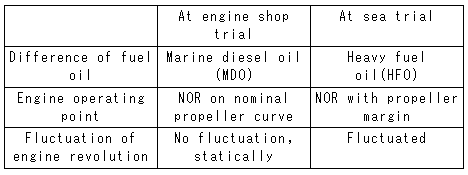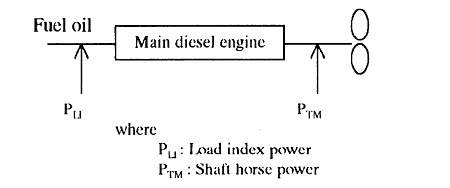3. FAULT TREE ANALYSIS FOR POWER MEASUREMENT
It is confirmed that load index power and shaft horse power have not been corresponded. Then, correctness of the engine output power measurement were investigated with fault tree analysis as shown in Figure 2.
Excepting both of no influencing factor and influenced which can be corrected exactly, the following factors are remained as influenced factor for engine output measurement.
(1) Difference of the fuel oil (heavy fuel oil or marine diesel oil)
(2) Difference between engine nominal operation rating and actual operating point
(3) Fluctuation of engine revolution
(4) Instrumental error of power meter
(5) Deviation of power meter zero point
The instrumental error and zero point deviation of the power meter are mechanical problem, but others are related to engine efficiency. Then, regard to the pointed factors which are influenced and are not corrected exactly as mentioned (1), (2) and (3), we investigated the difference between engine shop trial and sea trial as shown in Table 1. According to the consideration, it is understood that these difference between engine shop trial and sea trial have an influence on engine efficiency. Power calculation with load index is based on engine efficiency at shop trial, therefore, calculated power is not correspondence to shaft horse power measured by shaft power meter on the sea.

Table 1 Comparison shop trial with sea trial
4. CHARACTERISTIC OF LOAD INDEX POWER AND SHAFT HORSE POWER
In order to verify the result of fault tree analysis, characteristic of load index power and shaft horse power were analyzed as shown in Figure 3.

Figure 3 Characteristic of load index power and shalt horse power
Load index power is calculated with power estimation curve which shows the relation among the engine output measured by water brake, engine load index and engine speed at the shop trial. In other words, this is a calculation method with engine efficiency at the shop trial and is shown in equation (1). In connection with the equation (1), the load index power is shown in equation (2).
Q = LI × α1 × α2 × N × γ × H × K (1)
where
Q : Heat input for main diesel engine
LI : Load index
α1 : Correction coefficient of fuel injection pump
α2 : Correction coefficient of fuel voluminal elasticity
N : Engine speed
Y : Specific gravity of fuel oil
H : Calorific value of fuel oil
K : Constant
PLI = Q × ηo (2)
where
ηo : Base engine efficiency at shop trial
On the other hand, shaft horse power is shown in equation (3) which is calculated with heat input for main diesel engine and some efficiencies. The efficiencies are shown in equation (4).
PTM = Q × η (3)
η= ηo × βAIR × βCM × βFL × βOP (4)
where
η : Actual engine efficiency
βAIR : Correction coefficient of suction air temperature
BACK CONTENTS NEXT